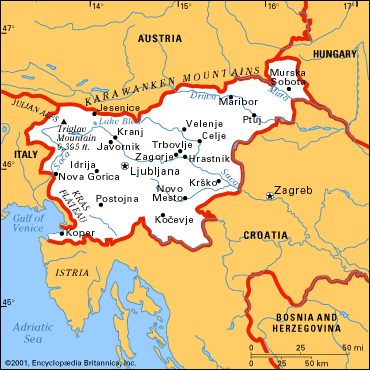
|
CHINA> About Slovenia
 |
|
Slovenia
(www.vlada.si)
Updated: 2009-07-24 14:44 The Republic of Slovenia lies at the heart of Europe where the Alps and the Mediterranean meet the Pannonian plains and the mysterious karst. To the north is Austria, to the east Hungary, to the south Croatia, and to the west Italy. According to the last census, a little under two million people live here on just over twenty thousand square kilometers.  Sloveniabecame an independent state in 1991. It has since established an international position and reputation as a democratic, stable and successful Central European country that is endeavouring to preserve its territorial integrity and the Slovene national identity while at the same time preserving its natural and cultural heritage. Sloveniabecame a member of the EU on May 1, 2004. Republicof Slovenia State / Democratic parliamentary republic since 25 June 1991 Member of the European Union since 1 May 2004 Capital/ Ljubljana, 260,000 inhabitants National flag/ Horizontal stripes in white, blue and red with Slovenian coat of arms on its left upper side Coat of arms/ Three six-pointed yellow stars are symbols of the Counts of Celje with Triglav as a symbol of Slovenehood and underlying two wavy lines symbolizing Slovenian rivers and the sea Anthem/ The seventh stanza of Zdravljica, a poem by France Prešeren, set to music by Stanko Premrl State holidays/ June 25 - Statehood Day, December 26 - Independence and Unity Day Official Language/ Slovene, in some nationally mixed border areas also Italian and Hungarian Currency/ EUR 1= 100 cents Phone dial code/ +386 Geography Size / 20,273 km² Length of borders/ 1,370 km: with Austria 318 km, with Italy 280 km, with Hungary 102 km, with Croatia 670 km Length of coastline/ 46.6 km Neighbouring states/ Austria, Italy, Hungary. Croatia Largest towns/ Ljubljana (261,700), Maribor (108,600), Kranj (39,400), Celje (38,400) Highest mountain/ Triglav 2,864 m Longest river/ Sava 221 km Landscape/ The territory of Slovenia is geographically divided into four basic types of landscape - Alpine in the north, Mediterranean in the south-west, Dinaric in the south and Pannonian in the east. Climate/ There are three different types of climate in Slovenia: continental in the central part, Alpine in the north-west and sub-Mediterranean along the coast and its hinterland. Population Inhabitants / 2,039,399 (30 June 2008) Population density/ 99.6 inhabitants per square kilometre Nationalities(2002 census): Slovenian 83%; Italian 0,1%; Hungarian 0,3%; Croat 1,8%; Serbian 2,0%; Muslim (including Bosniacs) 1,6%; others 2,2%; unknown: 8,9% Births/ On average 1,38 children per woman (2007) Life expectancy/ 74.98 for men and 82.26 for women (born in 2007) Urbanization/ Approximately one third of the population live in towns with more than 10,000 inhabitants, the rest live in nearly six thousand smaller towns and villages. Religions/ According to the 2002 census the most of population (58 %) are Catholics. Together there are 43 religious communities registered in Slovenia. Among the oldest is the Evangelical Church, most widely spread in the northeastern part of Slovenia. Political system Legislation / Under the Constitution, Slovenia is a democratic republic and a social state governed by law. The state’s authority is based on the principle of the separation of egislative, executive and judicial powers, with a parliamentary system of government. The highest legislative authority is the National Assembly (90 deputies), which has the right to enact laws. Elections to the National Assembly are held every four years. Suffrage/ According to the Constitution, the right to vote is universal and equal. Every citizen who has attained the age of eighteen years has the right to vote and stand for office. President/ Dr Danilo Türk since 2007 Prime Minister/ Borut Pahor (SD) since 2008 Parties represented in the National Assembly, elected on 21 September 2008 Social Democrats (SD), Slovenian Democratic Party (SDS), ZARES – nova politika, Democratic Party of Pensioners of Slovenia (DeSUS), Slovenian National Party (SNS), Slovenian People’s Party and Youth Party of Slovenia (SLS+SMS), Liberal Democracy of Slovenia (LDS), one representative each of the Hungarian and the Italian national communities. Economy Macroeconomic indices for Slovenia in 2007 Real GDP growth (real growth rate in %) 6.1 GDP per capita in EUR 16,615 Rate of unemployment by ILO in % 4.9 Labour productivity (real growth rate in %) 3.3 Inflation (annual average) 3.6
|